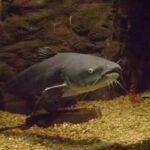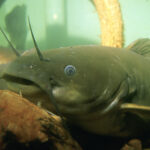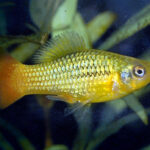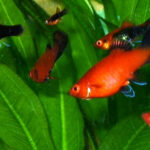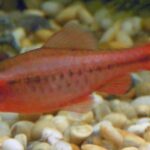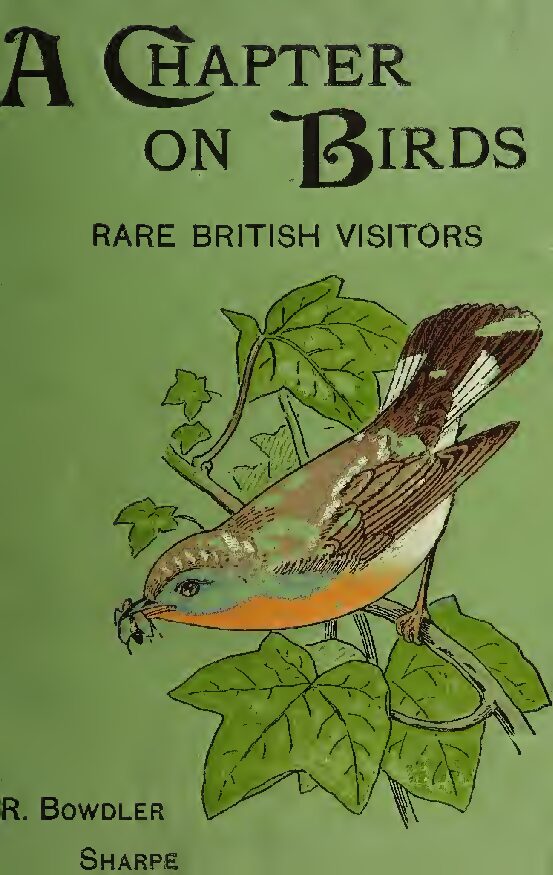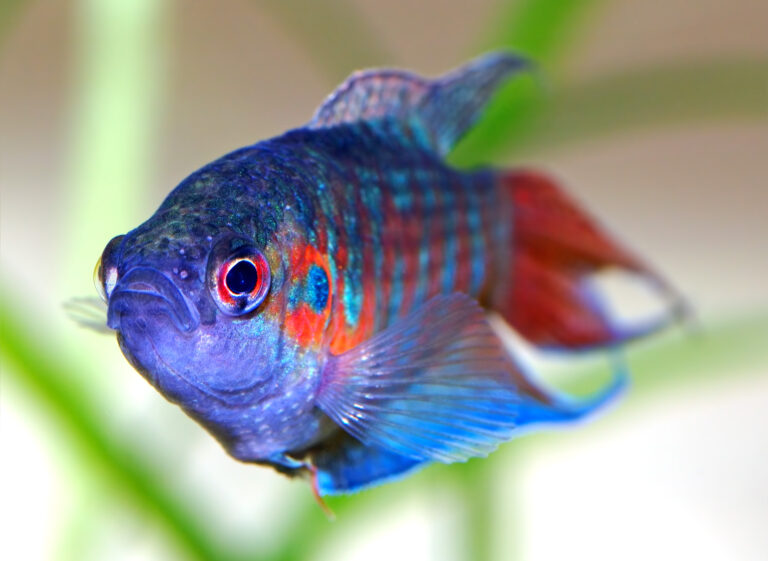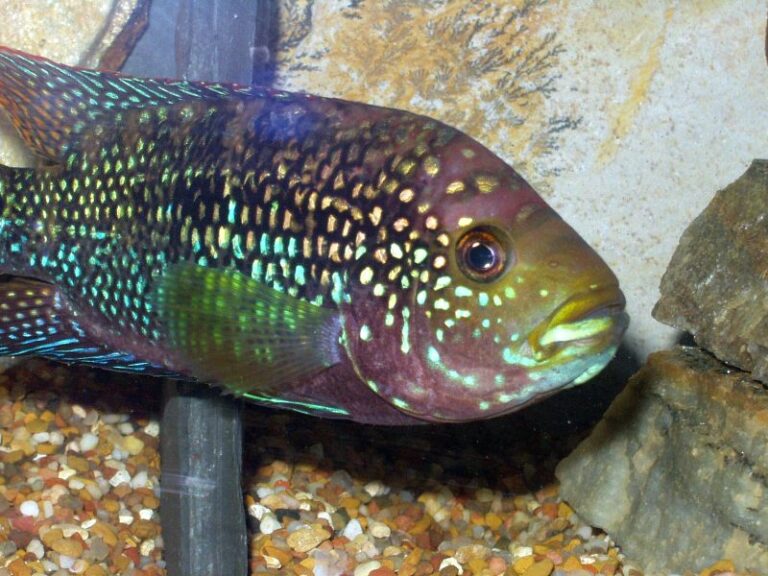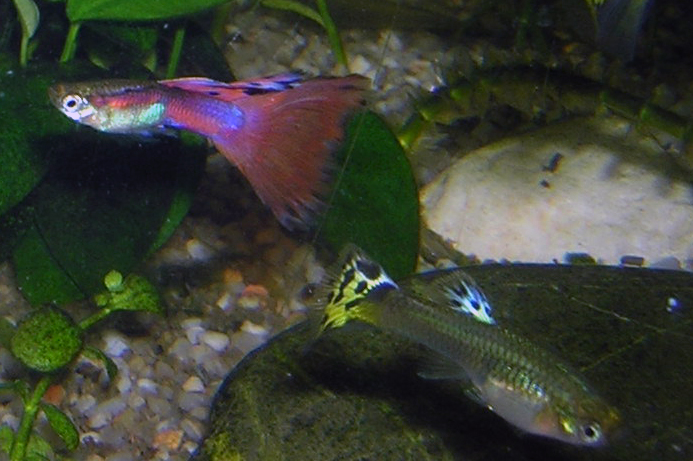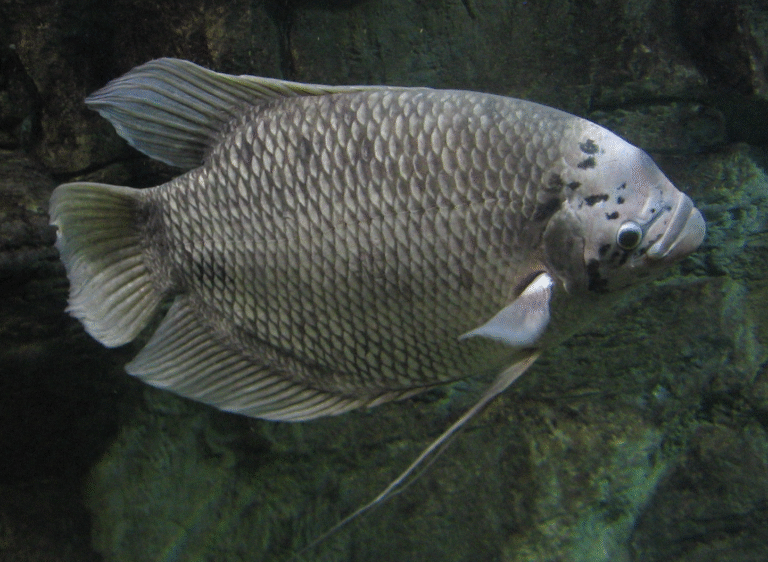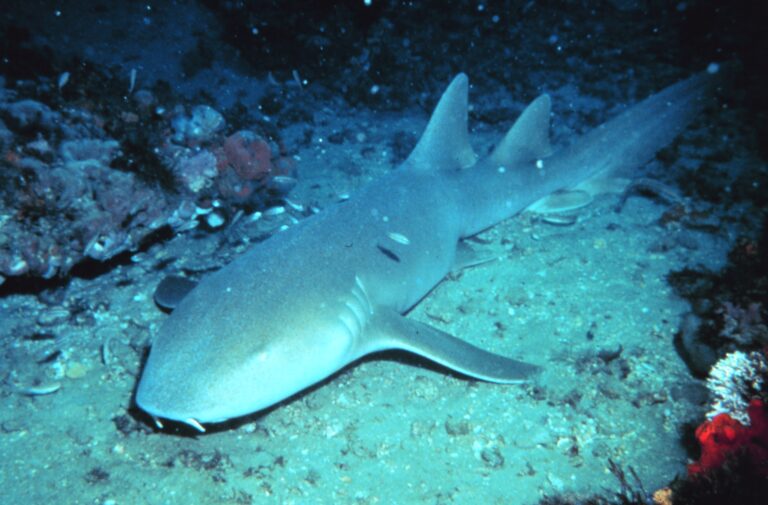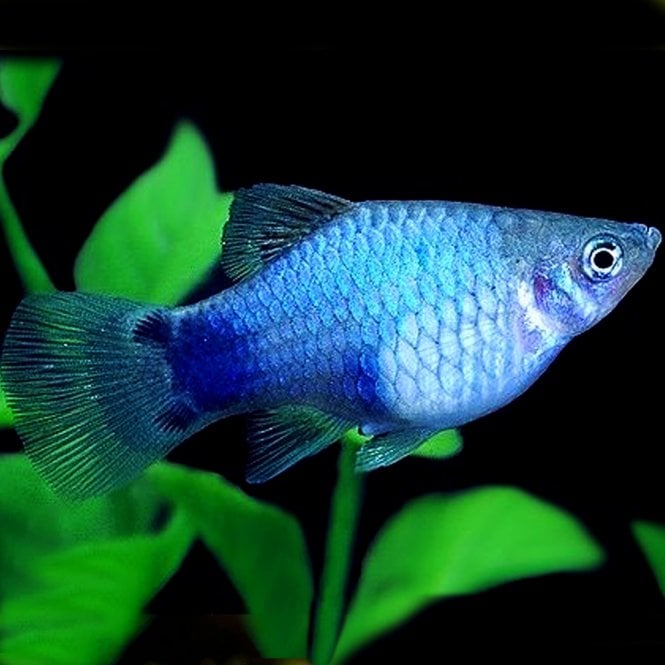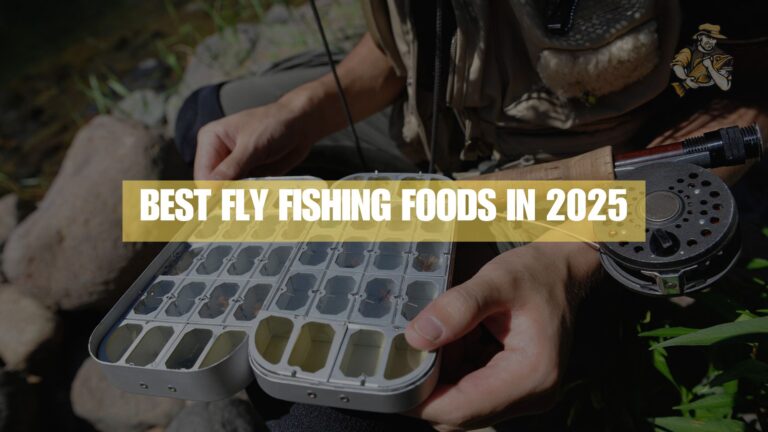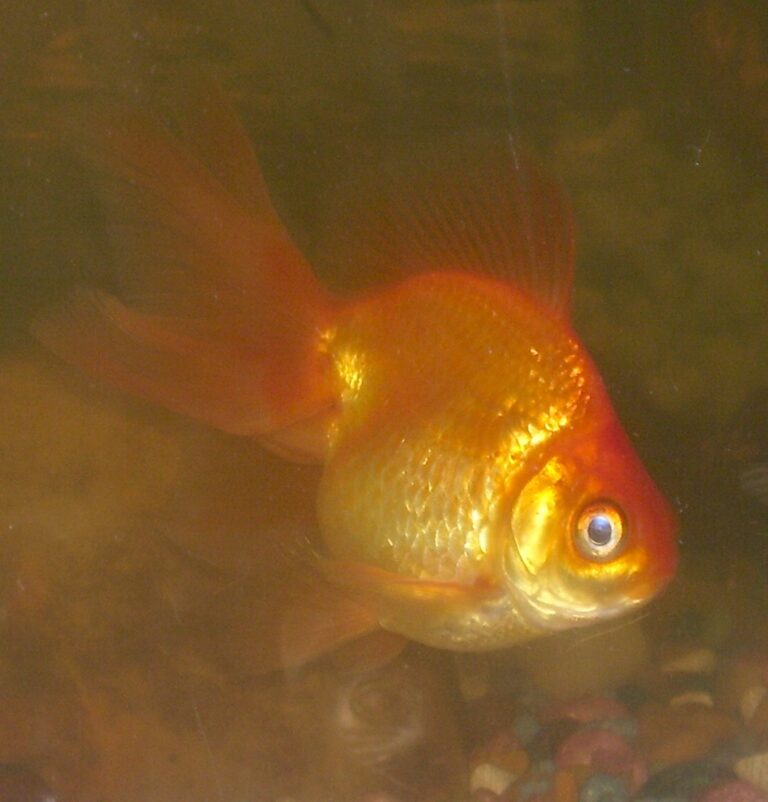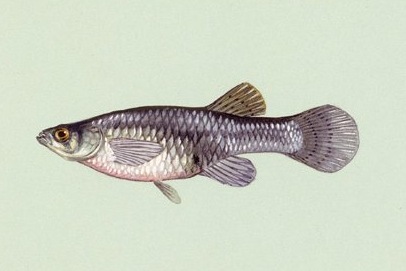Flowerhorn Cichlid
By Ryan Maron | Last Modified: June 9, 2025
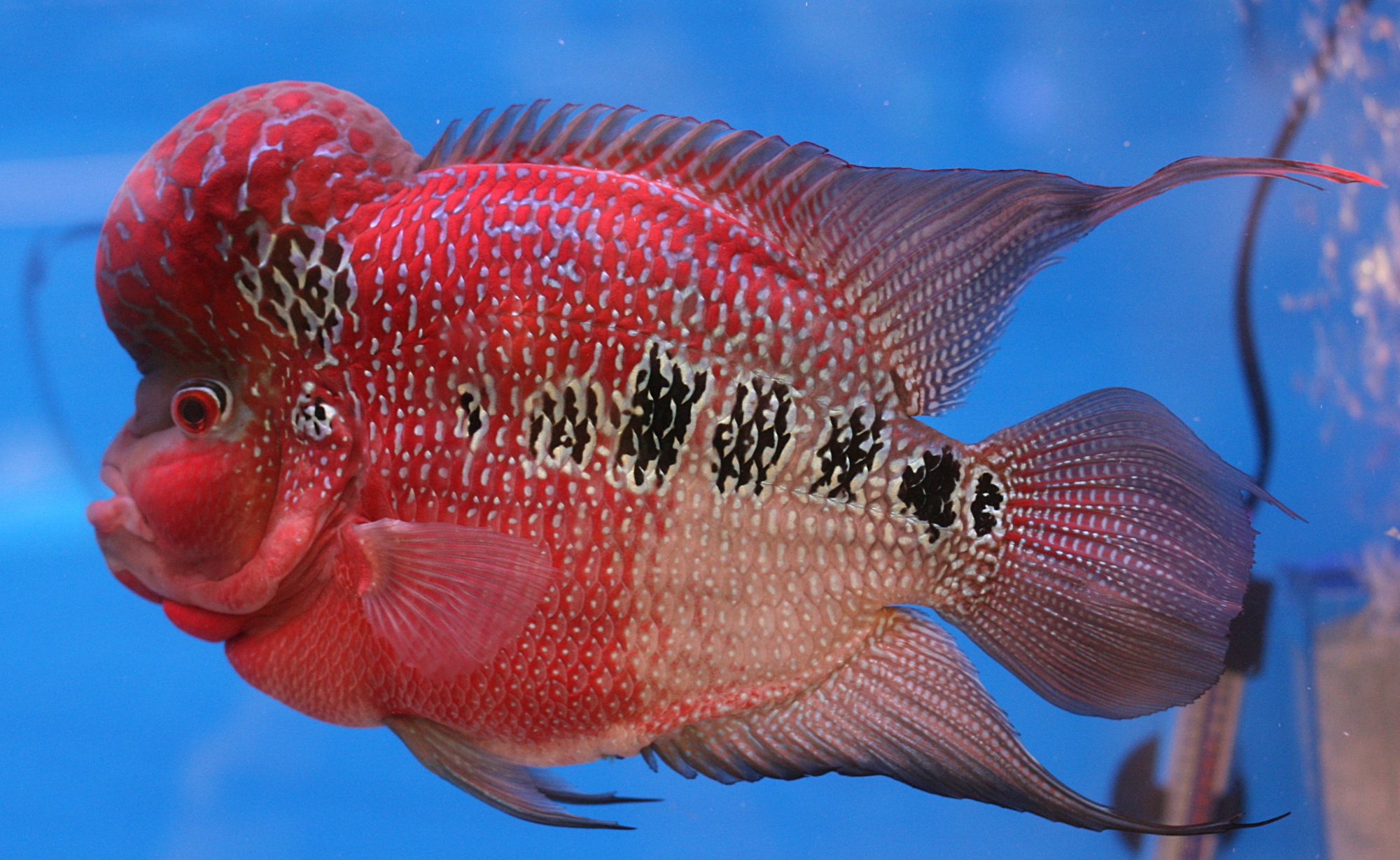
The Flowerhorn Cichlid represents one of the most distinctive and culturally significant hybrid fish species in contemporary aquarium keeping. Created through selective breeding programs beginning in the 1990s, this artificially developed cichlid combines genetic material from various Central American cichlid species, primarily blood parrots and trimac cichlids. The Flowerhorn Cichlid has achieved remarkable popularity across Southeast Asia and increasingly throughout global aquarium communities, valued both for its striking appearance and perceived cultural significance in feng shui practices.
While lacking natural ecological roles due to its hybrid origin, the Flowerhorn Cichlid occupies an important position in aquaculture economics and represents a fascinating example of human-directed fish breeding. These fish demonstrate complex behavioral patterns inherited from their wild cichlid ancestors, including territorial aggression, parental care instincts, and sophisticated social interactions. Understanding this species provides insights into cichlid biology, hybrid vigor, and the intersection between aquarium trade demands and selective breeding practices.
| Feature | Details |
|---|---|
| Common Name | Flowerhorn Cichlid |
| Scientific Name | Hybrid (No valid scientific name) |
| Family | Cichlidae |
| Typical Size | 25-40 cm (10-16 inches), 0.5-2 kg |
| Habitat | Aquarium-exclusive hybrid |
| Diet | Omnivorous |
| Distribution | Captive breeding facilities worldwide |
| Conservation Status | Not applicable (hybrid species) |
Taxonomy & Classification
The Flowerhorn Cichlid presents unique taxonomic challenges as an artificially created hybrid species lacking formal scientific classification. These fish originated from complex breeding programs involving multiple Central American cichlid species, primarily incorporating genetic material from red devil cichlids (Amphilophus labiatus), trimac cichlids (Amphilophus trimaculatus), and blood parrot cichlids themselves hybrid fish. The absence of natural populations means Flowerhorn Cichlids exist exclusively within the aquarium trade ecosystem.
Malaysian and Taiwanese breeders developed the first Flowerhorn strains during the 1990s through systematic crossbreeding programs aimed at enhancing coloration, head shape, and overall appearance. These breeding efforts focused on selecting specimens displaying pronounced nuchal humps, vibrant red and orange pigmentation, and distinctive marking patterns. The complex genetic heritage creates considerable phenotypic variation among individual fish, with offspring displaying unpredictable combinations of parental traits.
Modern Flowerhorn breeding recognizes several distinct strains, including Golden Base, Kamfa, Zhen Zhu, and Thai Silk varieties. Each strain exhibits characteristic features regarding head shape, color intensity, pattern distribution, and overall body proportions. The artificial nature of these classifications reflects human preference rather than natural evolutionary relationships, distinguishing Flowerhorn taxonomy from conventional fish species classification systems.
Physical Description
Flowerhorn Cichlids display remarkable physical characteristics that distinguish them from their wild cichlid ancestors. Adult specimens typically reach lengths between 25-40 centimeters and weights ranging from 0.5-2 kilograms, with males generally achieving larger sizes than females. The most distinctive feature remains the pronounced nuchal hump, or kok, which develops prominently in mature males and varies significantly in size and shape among different breeding strains.
Coloration represents perhaps the most striking aspect of Flowerhorn appearance, featuring intense reds, oranges, yellows, and metallic hues rarely observed in wild cichlid populations. The artificial selection for enhanced pigmentation has produced fish displaying almost fluorescent coloring, particularly in the red and orange spectrum. Many specimens exhibit complex pattern arrangements including spots, stripes, and marbled configurations that change subtly as fish mature and respond to environmental conditions.
Body structure reflects the robust build characteristic of Central American cichlids, with deep, laterally compressed bodies and powerful fin development. The dorsal and anal fins extend significantly, creating an imposing profile when fully displayed during territorial or courtship behaviors. Flowerhorn Cichlids possess strong, protruding lips inherited from their red devil cichlid ancestry, facilitating their omnivorous feeding strategies and contributing to their distinctive facial appearance.
The species exhibits pronounced sexual dimorphism, with males developing larger nuchal humps, more intense coloration, and extended fin development. Breeding tubercles may appear on mature males during spawning periods, while females typically maintain more subdued coloring and smaller overall size. These characteristics enable aquarists to distinguish breeding pairs, though individual variation can complicate sex determination in younger specimens.
Habitat & Distribution
The Flowerhorn Cichlid exists exclusively within artificial environments, having no natural habitat or wild distribution patterns. These hybrid fish inhabit aquarium systems worldwide, with the highest concentrations found throughout Southeast Asia, particularly Malaysia, Thailand, Singapore, and Taiwan where intensive breeding operations continue. Commercial breeding facilities maintain thousands of specimens in controlled environments designed to optimize growth rates, coloration development, and reproductive success.
Captive Flowerhorn populations require specific water parameters reflecting their Central American cichlid heritage. Optimal conditions include temperatures between 26-30°C, pH levels ranging from 6.5-7.8, and moderate to hard water conditions with dissolved mineral content supporting healthy physiological function. These parameters mirror the natural requirements of their parent species, which inhabit warm freshwater lakes and river systems throughout Central America.
Successful Flowerhorn maintenance demands substantial aquarium space, with minimum tank sizes of 300-400 liters for single adult specimens. The territorial nature inherited from wild cichlid ancestors necessitates adequate swimming space and environmental enrichment including caves, rocks, and substrate areas for natural foraging behaviors. Water quality management becomes critical given their large size and significant bioload production.
Regional breeding centers have established distinct Flowerhorn populations with characteristic traits reflecting local preferences and market demands. Malaysian farms focus on head shape development and metallic coloration, while Thai facilities emphasize pattern complexity and overall size achievement. These geographic variations in breeding priorities have created recognizable regional strains, though international trade continues to distribute genetic material globally.
Diet & Feeding Behavior
Flowerhorn Cichlids exhibit omnivorous feeding patterns inherited from their diverse cichlid ancestry, displaying opportunistic feeding behaviors that adapt readily to captive diet management. Their natural feeding instincts reflect the varied dietary requirements of Central American cichlids, incorporating both plant and animal matter through active foraging and predatory behaviors. The pronounced lip development facilitates substrate excavation and prey capture, enabling these fish to exploit multiple feeding niches within aquarium environments.
Commercial diet formulations designed specifically for large cichlids provide optimal nutrition for captive Flowerhorn populations. High-quality pellets containing 35-40% protein content support healthy growth rates and color development, while supplemental feeding with frozen or live foods enhances overall condition and reproductive readiness. Preferred food items include bloodworms, brine shrimp, small fish, and various invertebrates that stimulate natural hunting behaviors.
Feeding frequency and portion control require careful management due to the species’ voracious appetite and rapid growth potential. Adult specimens typically receive feeding sessions 2-3 times daily, with quantities adjusted to prevent overfeeding and maintain water quality standards. Juvenile fish require more frequent feeding schedules supporting accelerated growth phases, often necessitating 4-5 daily feeding sessions with appropriately sized food items.
The species demonstrates notable food recognition abilities and may develop preferences for specific food types or feeding routines. Many aquarists report that established Flowerhorn specimens recognize feeding times and display anticipatory behaviors, including increased activity levels and approach responses to aquarium glass. This behavioral plasticity reflects the cognitive abilities typical of large cichlid species and facilitates successful long-term captive management.
Behavior & Adaptations
Flowerhorn Cichlids display complex behavioral repertoires inherited from their Central American cichlid lineage, exhibiting sophisticated territorial, social, and reproductive behaviors despite their hybrid origin. These fish demonstrate remarkable intelligence and adaptability, often recognizing individual caretakers and responding to environmental changes with appropriate behavioral modifications. The combination of genetic material from multiple species has created fish displaying enhanced behavioral complexity compared to many single-species cichlids.
Territorial behavior represents the most prominent aspect of Flowerhorn conduct, with individuals establishing and defending specific areas within their environment through aggressive displays and physical confrontations. Males exhibit particularly intense territorial responses, especially during breeding periods when protective instincts become heightened. The species utilizes various threat displays including fin extension, color intensification, and aggressive positioning to communicate dominance and establish hierarchical relationships.
Social interactions reveal sophisticated communication abilities, with Flowerhorn Cichlids employing visual signals, body positioning, and behavioral patterns to convey information to conspecifics and other tank inhabitants. These fish recognize individual aquarists and may display different responses to familiar versus unfamiliar people, indicating advanced cognitive processing abilities. Some specimens develop interactive behaviors with their caretakers, approaching aquarium glass and following movement patterns outside their enclosure.
Environmental manipulation behaviors demonstrate the species’ intelligence and problem-solving capabilities. Flowerhorn Cichlids actively rearrange substrate materials, move decorative elements, and modify their immediate environment to suit their preferences. This behavior reflects natural nest-building and territory modification instincts while providing mental stimulation essential for psychological well-being in captive environments. Such behavioral complexity contributes to the species’ appeal among dedicated aquarists seeking interactive fish companions.
Reproduction & Life Cycle
Flowerhorn Cichlid reproduction follows patterns typical of substrate-spawning cichlids, though hybrid genetics introduce variability in reproductive success and offspring characteristics. Breeding pairs engage in elaborate courtship rituals involving color displays, territory establishment, and synchronized swimming patterns that strengthen pair bonds before spawning events. The complex genetic background occasionally results in reproductive challenges, including reduced fertility rates and developmental abnormalities in some breeding lines.
Sexual maturity occurs between 8-12 months of age, depending on growth rates, nutritional status, and environmental conditions. Successful breeding requires optimal water parameters, adequate space, and appropriate substrate materials for nest preparation. Spawning typically involves the female depositing 300-1000 eggs on cleaned surfaces while the male provides fertilization and subsequent protection of the breeding territory.
Parental care behavior demonstrates the strong protective instincts inherited from wild cichlid ancestors. Both parents participate in egg guarding, fry protection, and territory maintenance during the critical early developmental phases. The male typically assumes primary defensive responsibilities while the female focuses on direct offspring care, including fry herding and feeding supervision. This biparental care system significantly improves juvenile survival rates in appropriate breeding environments.
Fry development follows standard cichlid patterns, with eggs hatching after 3-4 days and free-swimming fry emerging within 7-10 days post-spawning. Young Flowerhorn Cichlids display rapid growth rates when provided with appropriate nutrition and environmental conditions. However, hybrid genetics create considerable variation in offspring appearance, with some fry displaying characteristics resembling parent species rather than typical Flowerhorn traits. This genetic variability presents both challenges and opportunities for selective breeding programs aimed at maintaining desired strain characteristics.
Predators & Threats
Flowerhorn Cichlids face no natural predators due to their exclusive existence within captive environments, though several significant threats impact their survival and well-being in aquarium systems. The primary threats stem from inadequate husbandry practices, including improper water quality management, insufficient space provision, and inappropriate dietary regimens that compromise immune system function and overall health status.
Disease susceptibility represents a major concern for Flowerhorn populations, with several bacterial, parasitic, and viral infections capable of causing significant mortality. Hole-in-the-head disease, often associated with poor water quality and nutritional deficiencies, affects many specimens and can result in permanent damage or death if left untreated. Ich, bacterial infections, and various parasitic conditions pose ongoing challenges requiring vigilant monitoring and appropriate treatment protocols.
Aggressive tankmate interactions constitute another significant threat, particularly when Flowerhorn Cichlids are housed with inappropriate species or in overcrowded conditions. Their territorial nature and substantial size make them incompatible with many common aquarium fish, potentially resulting in fatal confrontations or chronic stress conditions that compromise immune system function. Careful species selection and adequate space provision help mitigate these risks.
Environmental stressors including temperature fluctuations, pH instability, and inadequate filtration systems create chronic stress conditions that predispose Flowerhorn Cichlids to various health problems. The species’ large size and significant bioload production demand robust filtration systems and consistent water quality maintenance. Neglect of these environmental requirements often results in deteriorating health conditions and reduced lifespan, making proper husbandry practices essential for long-term survival.
Conservation Status
The Flowerhorn Cichlid lacks formal conservation status designation due to its hybrid origin and exclusive existence within captive breeding programs. No wild populations exist to protect or monitor, making traditional conservation assessments inapplicable to this artificially created species. However, the genetic diversity and breeding line preservation of Flowerhorn strains present important considerations for maintaining the long-term viability of this aquarium trade staple.
Breeding program sustainability represents the primary conservation concern for Flowerhorn Cichlids, with several distinct strains requiring careful genetic management to prevent inbreeding depression and maintain desirable characteristics. Commercial breeding facilities maintain extensive breeding records and outcrossing programs designed to preserve genetic diversity within established lines while preventing the loss of distinctive traits that define specific strains.
The risk of escaped specimens establishing invasive populations in suitable habitats creates potential ecological concerns, though no confirmed wild populations currently exist. Flowerhorn Cichlids possess the biological characteristics necessary for survival in warm freshwater environments, particularly in tropical regions with suitable water parameters. Responsible aquarium keeping practices and education regarding proper disposal of unwanted specimens help minimize introduction risks.
International trade regulations occasionally impact Flowerhorn availability and movement between countries, though these restrictions typically focus on preventing invasive species establishment rather than species conservation. Some regions have implemented import restrictions or quarantine requirements to minimize ecological risks associated with escaped aquarium fish. These regulatory measures balance the economic benefits of the aquarium trade with environmental protection responsibilities.
Human Interaction
The Flowerhorn Cichlid maintains an exclusively human-dependent relationship, existing solely through artificial breeding programs and aquarium keeping practices. This species represents a unique example of human-directed evolution, with selective breeding efforts producing fish that differ dramatically from their wild ancestors in appearance, behavior, and overall characteristics. The relationship demonstrates the profound impact of human preferences on fish development and the aquarium trade industry.
Cultural significance varies considerably across different regions, with Southeast Asian communities often attributing feng shui properties and good fortune associations to Flowerhorn ownership. These cultural beliefs have driven substantial market demand and influenced breeding priorities, with specific traits such as pronounced head humps and vibrant coloration considered particularly auspicious. The intersection of cultural traditions and aquarium keeping has created a substantial economic market supporting thousands of breeding operations.
Economic impact within the aquarium trade represents one of the most significant aspects of human-Flowerhorn interaction. Premium specimens command substantial prices, often ranging from hundreds to thousands of dollars for exceptional individuals displaying ideal characteristics. This economic value supports extensive breeding programs, specialized food manufacturers, and aquarium equipment suppliers focused on cichlid species maintenance.
Educational value emerges from Flowerhorn keeping experiences, with many aquarists gaining insights into cichlid behavior, breeding techniques, and advanced aquarium management through their involvement with these complex fish. The species serves as an introduction to large cichlid keeping and demonstrates the principles of selective breeding and hybrid development. Many serious aquarists credit their Flowerhorn experiences with developing the skills and knowledge necessary for maintaining other challenging fish species.
Interesting Facts
The development of Flowerhorn Cichlids represents one of the most successful artificial breeding programs in aquarium history, transforming from initial experimental crosses to a multi-million dollar international industry within approximately two decades. The speed of this development demonstrates the powerful influence of market demand and cultural preferences on aquarium fish breeding priorities.
Individual Flowerhorn specimens can live 10-12 years under optimal conditions, developing increasingly pronounced characteristics as they mature. The nuchal hump continues growing throughout their lifetime, with some exceptional males developing humps that extend significantly beyond their head profile. This continued development maintains interest among aquarists who enjoy observing long-term changes in their fish.
Color-changing abilities allow Flowerhorn Cichlids to modify their appearance based on mood, environmental conditions, and social situations. Stress, excitement, breeding readiness, and territorial disputes all trigger different color responses, creating dynamic visual displays that enhance their appeal among aquarium enthusiasts. These color changes occur within minutes and reflect the complex physiological responses inherited from their wild ancestors.
The species demonstrates remarkable learning abilities, with many specimens recognizing feeding schedules, responding to their names, and performing simple tricks for food rewards. Some aquarists report that their Flowerhorn Cichlids distinguish between different people and display varying degrees of responsiveness based on familiarity levels. This intelligence contributes to their reputation as interactive pets rather than merely decorative aquarium inhabitants.
Regional breeding competitions celebrate exceptional Flowerhorn specimens, with judges evaluating head shape, color intensity, pattern complexity, and overall condition. These competitions drive continued breeding improvements and establish market values for superior specimens. Winners often command premium prices and become foundation stock for future breeding programs, perpetuating the cycle of selective improvement that characterizes Flowerhorn development.
Frequently Asked Questions
What tank size do Flowerhorn Cichlids require?
Adult Flowerhorn Cichlids require minimum tank sizes of 300-400 liters (75-100 gallons) for single specimens, with larger tanks preferred for optimal health and behavior. Their territorial nature and substantial size demand adequate swimming space and robust filtration systems to maintain appropriate water quality standards.
Can Flowerhorn Cichlids be kept with other fish?
Flowerhorn Cichlids are generally aggressive and territorial, making tankmate selection extremely challenging. Most specimens are best maintained as solitary fish, though some aquarists successfully house them with equally large and aggressive species such as Oscar fish in appropriately sized aquariums with careful monitoring.
How can you determine the sex of a Flowerhorn Cichlid?
Males typically develop larger nuchal humps, more intense coloration, and extended fin development compared to females. Breeding tubercles may appear on mature males during spawning periods, while females generally maintain smaller size and more subdued coloring. However, individual variation can make sex determination challenging in younger specimens.
What water parameters do Flowerhorn Cichlids prefer?
Optimal conditions include temperatures between 26-30°C (79-86°F), pH levels ranging from 6.5-7.8, and moderate to hard water conditions. These parameters reflect their Central American cichlid heritage and support healthy physiological function, growth rates, and color development in captive environments.
Conclusion
The Flowerhorn Cichlid stands as a remarkable testament to human influence on fish development, representing successful artificial selection that created one of the aquarium trade’s most distinctive species. While lacking natural ecological significance, these hybrid fish demonstrate the complex behaviors and care requirements typical of large Central American cichlids, requiring dedicated aquarists capable of providing appropriate environmental conditions and long-term commitment. Their continued popularity ensures ongoing breeding programs that preserve genetic diversity while advancing the selective traits that make Flowerhorn Cichlids unique ambassadors for advanced aquarium keeping techniques.
Share The Article:
More Fish Species:
-
Delta Tail Betta
The Delta Tail Betta (Betta splendens) represents one of the most recognizable and sought-after varieties within the aquarium trade,…
-
Paradise Fish
The Paradise Fish stands as one of the most remarkable representatives of the labyrinth fish family, captivating aquarists and…
-
Jack Dempsey Fish
The Jack Dempsey Fish stands as one of Central America’s most distinctive cichlid species, captivating aquarists and researchers alike…
-
Guppy
The Guppy (Poecilia reticulata) stands as one of the most recognizable and extensively studied freshwater fish species in the…
-
Giant Gourami
The Giant Gourami (Osphronemus goramy) represents one of the most remarkable freshwater fish species in Southeast Asia, distinguished by…
-
Nurse Shark
The Nurse Shark (Ginglymostoma cirratum) stands as one of the most recognizable and ecologically significant bottom-dwelling sharks in tropical…
Discover
-
7 Best Places to Go Fishing in Florida (2025 Guide for All Anglers)
Florida’s known as the Fishing Capital of the World for good reason. With over 7,700 lakes, 10,550 miles of…
-
River Fishing Techniques: Master the Moving Water
Fishing rivers presents a unique set of challenges and rewards that I’ve come to appreciate over my three decades…
-
North Jersey Fishing Guide: Best Lakes, Rivers & Seasons
If you’ve never experienced the fishing in North Jersey, you’re missing out on some genuinely underrated angling opportunities. From…
-
How to Find Good Fishing Spots That Actually Produce Fish
Finding productive fishing spots is often what separates successful anglers from those who go home empty-handed. It’s not just…
-
Best Fishing Spots in California: Lakes, Rivers, and Coastal Hotspots
California fishing has always struck me as a study in beautiful contradictions. From snow-fed alpine lakes to sweltering desert…
-
Why Your Red Drum Strategy Is All Wrong (Fix It Today)
Last October, I was fishing the eastern shore of Lake Michigan near Ludington with my buddy Mike. Cold front…
Discover
-
Blue Platy
The Blue Platy (Xiphophorus maculatus) stands as one of the most recognizable and culturally significant freshwater fish species in…
-
Red Devil Cichlid
The Red Devil Cichlid stands as one of Central America’s most formidable and captivating freshwater predators, renowned for its…
-
7 Best Fly Fishing Foods That Trout Can’t Resist in 2025
If there’s one thing I’ve learned after three decades of fly fishing, it’s that trout can be maddeningly selective…
-
Fantail Goldfish
The Fantail Goldfish represents one of the most recognizable and beloved fancy goldfish varieties in the aquarium trade worldwide….
-
Mosquito Fish
The Mosquito Fish (Gambusia affinis) stands as one of North America’s most ecologically significant freshwater species, despite its diminutive…
-
Chinook Salmon: Essential Guide for Catching Kings
There’s something almost magical about the moment when a Chinook salmon takes your lure. That heart-stopping tug, followed by…

